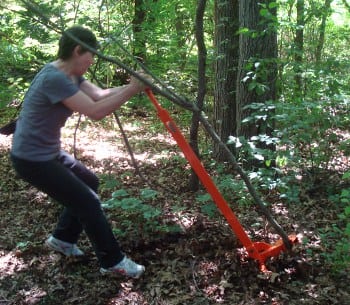Reviewed by Maureen Sundberg
You’re clearing and widening a trail at a local park, or you’re clearing an overgrown area to expand a perennial bed. All is going well until you come upon a grove of buckthorn. You can grab a shovel and start digging, pulling, digging, pulling. Or you can grab a Weed Wrench.
That’s what Bruce Wenning has done on recent invasive plant removal projects. He met me to demonstrate use of his Weed Wrench and to let me try it out on a few invasive plants. Using his Medium Weed Wrench, I could easily pull up 1½ inch saplings that were impossible to pull without help. And it was simple. No complicated instructions, special commentaries, scary advisories. Just press the jaws in place around the trunk at ground level, hold down with one foot as you begin applying pressure, then let your weight pull the lever until the roots come free.
We tried out the Weed Wrench on buckthorn, cherry, and bittersweet. The bittersweet tended to crush and the roots broke. I was advised not to try the Weed Wrench on knotweed as the stems would also crush and tear. But with woody plants like European and Common buckthorn, the Weed Wrench made removal easy after a couple of minutes of instruction.
In my opinion, this is the perfect tool for the eco-conscious. The Weed Wrench is manually operated, fueled by human effort alone. It’s a simple tool – a lever – that allows you to pull out a plant that would otherwise take two or three people to remove. Constructed of heavy steel, it’s basically a set of powerful jaws attached to a sturdy handle. The jaws grip a targeted plant, the handle provides leverage for wresting out well-rooted plants with minimal soil disturbance.
The Weed Wrench, according to the company’s website, was a tool born out of need. Working on an invasives removal project outside San Francisco in 1988, Tom Ness watched volunteers struggle to remove French broom. In response, he welded together a tool that became the Weed Wrench. Groups across the country had an interest in his device, and his company now manufactures the Weed Wrench in Oregon and ships throughout the US.
The tool comes in four sizes: Mini, Light, Medium, and Heavy. Jaw sizes range from one inch to two and one half inches and have corresponding longer handles – 24 inches for the Mini up to 60 inches for the Heavy. I used the Medium Weed Wrench to remove buckthorn that was about two inches in diameter. I needed a little help with a two-inch cherry with its longer tap root. At 17.5 pounds, the Medium wasn’t light, but I could carry it short distances.
A Weed Wrench is a fairly expensive item: $155 plus shipping for the Medium that I tried out. Given the cost, it would be a good item to share among organizations. In fact, the Weed Wrench website offers a bulletin board for parties to post requests for tool sharing opportunities and notices about used tools either sought or offered for sale.
For me, knowing there’s a tool that makes clearing some of the larger problem trees and shrubs somewhat easier is a great motivator. And given the satisfaction I felt pulling up some sizable invaders with the Weed Wrench, I’ll be looking for more opportunities to remove invasives.
2016 Note: The Weed Wrench is no longer being manufactured, but there are a few similar products available, including the Uprooter and the Extractigator.
2022 Note: Curtis Pearce at Uprooter has taken over manufacturing the Weed Wrench.
About the Author
Maureen Sundberg writes, gardens, and thwarts invasives at home in Andover, MA. She has served on the ELA Board of Directors since 2007 and currently edits the ELA Newsletter. Contact her at office@ecolandscaping.org, subject line “Newsletter.”





